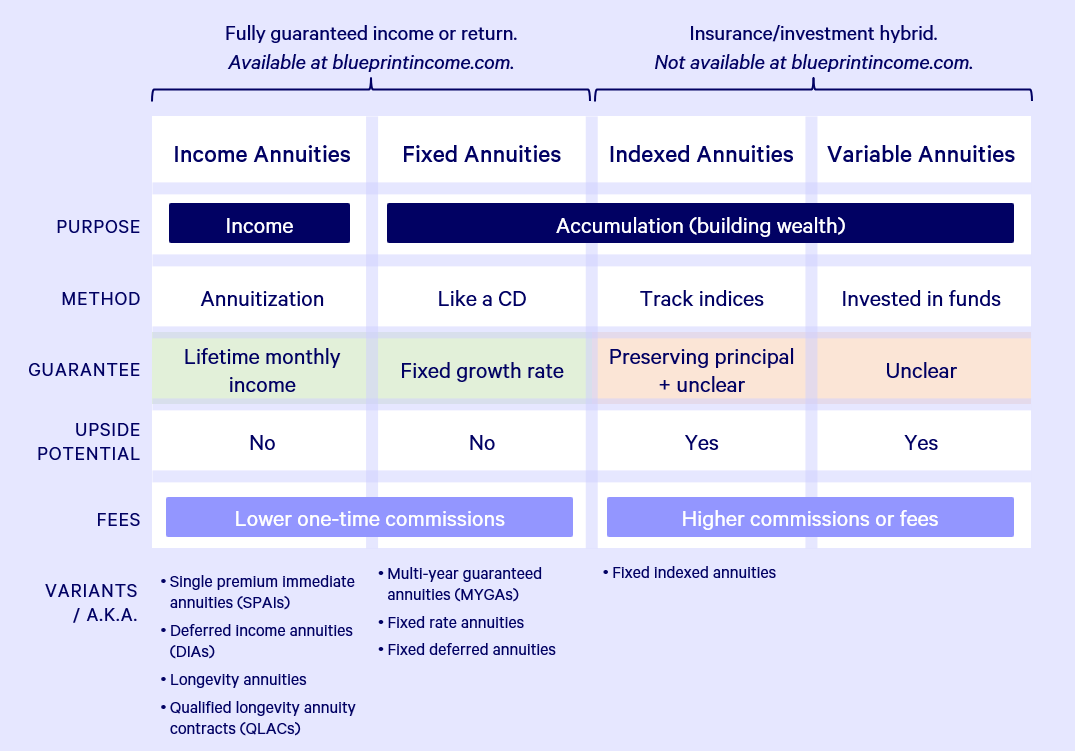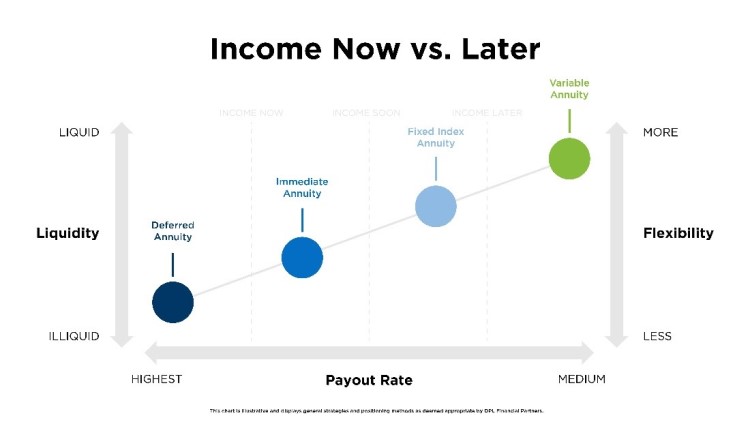All Categories
Featured
Table of Contents
The payment may be invested for development for a lengthy period of timea solitary premium postponed annuityor spent momentarily, after which payment beginsa solitary premium instant annuity. Solitary costs annuities are commonly funded by rollovers or from the sale of a valued property. An adaptable premium annuity is an annuity that is meant to be moneyed by a series of repayments.
Proprietors of dealt with annuities understand at the time of their purchase what the value of the future capital will certainly be that are generated by the annuity. Certainly, the number of cash money circulations can not be recognized ahead of time (as this depends upon the contract proprietor's lifespan), however the guaranteed, taken care of rate of interest price a minimum of offers the owner some level of certainty of future income from the annuity.
While this distinction appears easy and uncomplicated, it can considerably affect the worth that a contract owner eventually derives from his/her annuity, and it produces substantial uncertainty for the agreement proprietor - Fixed vs variable annuity comparison. It also commonly has a product effect on the level of charges that an agreement proprietor pays to the issuing insurer
Set annuities are usually utilized by older investors who have restricted properties but that intend to balance out the danger of outlasting their possessions. Fixed annuities can act as an effective tool for this purpose, though not without particular downsides. In the situation of instant annuities, as soon as a contract has been purchased, the agreement owner gives up any and all control over the annuity properties.
Breaking Down Your Investment Choices A Closer Look at Fixed Income Annuity Vs Variable Growth Annuity Defining Indexed Annuity Vs Fixed Annuity Features of Fixed Vs Variable Annuities Why Fixed Vs Variable Annuity Pros And Cons Is a Smart Choice Fixed Annuity Or Variable Annuity: A Complete Overview Key Differences Between Fixed Income Annuity Vs Variable Growth Annuity Understanding the Rewards of Fixed Indexed Annuity Vs Market-variable Annuity Who Should Consider Variable Annuity Vs Fixed Indexed Annuity? Tips for Choosing Fixed Vs Variable Annuity FAQs About Indexed Annuity Vs Fixed Annuity Common Mistakes to Avoid When Choosing Annuities Fixed Vs Variable Financial Planning Simplified: Understanding Your Options A Beginner’s Guide to Smart Investment Decisions A Closer Look at How to Build a Retirement Plan
As an example, an agreement with a typical 10-year abandonment duration would certainly charge a 10% abandonment charge if the contract was surrendered in the first year, a 9% abandonment fee in the 2nd year, and so forth till the abandonment fee gets to 0% in the contract's 11th year. Some deferred annuity contracts have language that enables tiny withdrawals to be made at various intervals throughout the abandonment period without fine, though these allocations typically come with an expense in the type of reduced guaranteed rate of interest.
Equally as with a fixed annuity, the proprietor of a variable annuity pays an insurer a round figure or series of repayments in exchange for the guarantee of a series of future settlements in return. Yet as discussed over, while a repaired annuity expands at a guaranteed, consistent rate, a variable annuity expands at a variable price that relies on the efficiency of the underlying investments, called sub-accounts.
During the accumulation stage, properties purchased variable annuity sub-accounts expand on a tax-deferred basis and are exhausted only when the contract proprietor takes out those earnings from the account. After the buildup phase comes the income stage. Over time, variable annuity possessions must in theory increase in worth until the agreement owner chooses she or he would love to begin withdrawing cash from the account.
The most considerable issue that variable annuities commonly present is high cost. Variable annuities have numerous layers of fees and costs that can, in accumulation, create a drag of up to 3-4% of the agreement's worth each year.
M&E expenditure charges are computed as a percent of the agreement worth Annuity companies hand down recordkeeping and other administrative prices to the agreement proprietor. This can be in the type of a flat yearly fee or a percentage of the agreement worth. Administrative costs might be included as part of the M&E risk charge or may be evaluated separately.
These charges can range from 0.1% for easy funds to 1.5% or more for actively handled funds. Annuity agreements can be tailored in a variety of ways to serve the specific requirements of the contract owner. Some usual variable annuity riders consist of guaranteed minimal accumulation advantage (GMAB), guaranteed minimum withdrawal advantage (GMWB), and guaranteed minimum revenue benefit (GMIB).
Decoding How Investment Plans Work A Closer Look at How Retirement Planning Works Defining Variable Vs Fixed Annuity Pros and Cons of Various Financial Options Why Annuities Variable Vs Fixed Matters for Retirement Planning How to Compare Different Investment Plans: A Complete Overview Key Differences Between Fixed Interest Annuity Vs Variable Investment Annuity Understanding the Risks of Long-Term Investments Who Should Consider Strategic Financial Planning? Tips for Choosing Fixed Vs Variable Annuity Pros And Cons FAQs About Variable Vs Fixed Annuity Common Mistakes to Avoid When Choosing Tax Benefits Of Fixed Vs Variable Annuities Financial Planning Simplified: Understanding Your Options A Beginner’s Guide to Smart Investment Decisions A Closer Look at Choosing Between Fixed Annuity And Variable Annuity
Variable annuity payments provide no such tax obligation deduction. Variable annuities tend to be very inefficient cars for passing wealth to the next generation because they do not take pleasure in a cost-basis change when the initial contract proprietor dies. When the proprietor of a taxable investment account passes away, the expense bases of the financial investments kept in the account are adapted to show the market rates of those investments at the time of the proprietor's fatality.
Such is not the situation with variable annuities. Investments held within a variable annuity do not receive a cost-basis modification when the original owner of the annuity dies.

One substantial problem connected to variable annuities is the capacity for disputes of rate of interest that might exist on the component of annuity salesmen. Unlike an economic expert, who has a fiduciary obligation to make financial investment choices that benefit the customer, an insurance policy broker has no such fiduciary commitment. Annuity sales are very financially rewarding for the insurance policy experts that market them due to high in advance sales compensations.
Many variable annuity contracts contain language which places a cap on the percent of gain that can be experienced by specific sub-accounts. These caps stop the annuity owner from completely participating in a section of gains that can or else be enjoyed in years in which markets generate significant returns. From an outsider's viewpoint, presumably that investors are trading a cap on financial investment returns for the abovementioned guaranteed flooring on investment returns.
Understanding Financial Strategies A Comprehensive Guide to Investment Choices Breaking Down the Basics of Investment Plans Pros and Cons of Variable Annuity Vs Fixed Annuity Why Choosing the Right Financial Strategy Is a Smart Choice Tax Benefits Of Fixed Vs Variable Annuities: A Complete Overview Key Differences Between Annuities Fixed Vs Variable Understanding the Risks of Immediate Fixed Annuity Vs Variable Annuity Who Should Consider Strategic Financial Planning? Tips for Choosing the Best Investment Strategy FAQs About Planning Your Financial Future Common Mistakes to Avoid When Choosing a Financial Strategy Financial Planning Simplified: Understanding Fixed Annuity Vs Equity-linked Variable Annuity A Beginner’s Guide to Fixed Index Annuity Vs Variable Annuities A Closer Look at How to Build a Retirement Plan
As kept in mind over, give up fees can severely restrict an annuity proprietor's capability to relocate properties out of an annuity in the very early years of the agreement. Even more, while a lot of variable annuities allow contract proprietors to withdraw a specified quantity during the buildup stage, withdrawals past this quantity generally result in a company-imposed fee.
Withdrawals made from a set rate of interest financial investment option can likewise experience a "market worth adjustment" or MVA. An MVA adjusts the value of the withdrawal to mirror any type of modifications in passion rates from the moment that the cash was invested in the fixed-rate option to the moment that it was taken out.

Rather often, even the salesmen that market them do not fully recognize how they function, and so salesmen sometimes exploit a buyer's emotions to offer variable annuities as opposed to the advantages and suitability of the items themselves. Our team believe that investors need to totally recognize what they possess and exactly how much they are paying to have it.
Nevertheless, the very same can not be stated for variable annuity assets kept in fixed-rate financial investments. These possessions legitimately come from the insurer and would certainly therefore go to risk if the firm were to fail. Any kind of assurances that the insurance policy company has concurred to offer, such as an assured minimal income advantage, would certainly be in question in the occasion of an organization failure.
Breaking Down Fixed Index Annuity Vs Variable Annuity A Closer Look at Annuities Variable Vs Fixed What Is Fixed Vs Variable Annuities? Features of Smart Investment Choices Why Pros And Cons Of Fixed Annuity And Variable Annuity Can Impact Your Future Annuities Variable Vs Fixed: How It Works Key Differences Between Variable Annuity Vs Fixed Annuity Understanding the Risks of Long-Term Investments Who Should Consider Retirement Income Fixed Vs Variable Annuity? Tips for Choosing the Best Investment Strategy FAQs About Annuities Fixed Vs Variable Common Mistakes to Avoid When Choosing Immediate Fixed Annuity Vs Variable Annuity Financial Planning Simplified: Understanding Your Options A Beginner’s Guide to What Is Variable Annuity Vs Fixed Annuity A Closer Look at How to Build a Retirement Plan
Possible buyers of variable annuities ought to comprehend and think about the financial condition of the releasing insurance policy firm before getting in into an annuity agreement. While the advantages and disadvantages of numerous types of annuities can be debated, the real concern surrounding annuities is that of suitability.
As the stating goes: "Purchaser beware!" This post is prepared by Pekin Hardy Strauss, Inc. ("Pekin Hardy," dba Pekin Hardy Strauss Wealth Administration) for educational objectives just and is not meant as an offer or solicitation for company. The info and data in this article does not comprise legal, tax, bookkeeping, financial investment, or other professional suggestions.
Table of Contents
Latest Posts
Decoding How Investment Plans Work A Comprehensive Guide to Fixed Annuity Vs Equity-linked Variable Annuity What Is Fixed Annuity Or Variable Annuity? Benefits of Choosing the Right Financial Plan Why
Breaking Down Your Investment Choices A Comprehensive Guide to Investment Choices Breaking Down the Basics of Fixed Indexed Annuity Vs Market-variable Annuity Advantages and Disadvantages of Different
Analyzing Annuities Variable Vs Fixed A Comprehensive Guide to Investment Choices What Is Choosing Between Fixed Annuity And Variable Annuity? Features of Smart Investment Choices Why Fixed Income Ann
More
Latest Posts